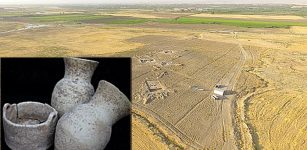Huge 7,000-Year-Old Man-Made Structures Used For Religious Rituals Spotted In Poland
Jan Bartek - AncientPages.com - Giant 7,000-year-old ring-shaped structures have been discovered in the village of Nowe Objezierze, located within Gryfino County, West Pomeranian Voivodeship, in north-western Poland.
These structures (used for religious rituals) could have been as entrances to the object, according to researchers.
It is thought they are among the oldest man-made structures in Europe.
 Roundel in Tylice visible on the orthophotomap (credit: M. Sosnowski, source: Google Earth).
Roundel in Tylice visible on the orthophotomap (credit: M. Sosnowski, source: Google Earth).
The discovery was made when data from Google Maps and Google Earth, was analyzed by researchers from the Institute of Archaeology and Ethnology of the Polish Academy of Sciences.
Looking for traces of ancient human activity they spotted two circular outlines about 85 m in diameter about 5 km from each other.
Each ring consists of a system of three oval ditches with a common center. One of the structures (called a roundel, which refers to the circular shape) has visible gaps in the ditch system.
”It is also interesting that the probable entrances are located exactly opposite each other, on the north-west - south-east axis. We believe that they may also have been associated with astronomical observations," Mateusz Sosnowski from the Institute of Archaeology of the Nicolaus Copernicus University, said in a press release.
Roundel in Tylice, hypsometric plan with the outlines of the ditches of the discovered object (credit: J. Czerniec).
According to the archaeologist, the entrances are probably directed towards the rising sun during the winter solstice. However, further analysis will be needed to confirm this hypothesis. It is believed that such large structures had to be planned and built by a large group of people.
See also:
Unusual Medieval Knife Used Like An Eraser Discovered In Poland
Giant 7,000-Year-Old Astronomical Calendar Discovered In Poland?
To date, more than 130 roundels have been located in Europe, a third of them in Austria. The rest are in today`s Hungary, Slovakia, the Czech Republic, and Germany. In 2014, only three such structures were known in Poland. Currently, there are now 10 known roundels.
”Our discovery can be called sensational due to the fact that the roundels are located east of the Vistula River. These are the northeasternmost structures of this type in Europe. We did not expect such a discovery in this area,” Sosnowski added.
 Roundel in Łysomice, hypsometric plan with the outlines of the ditches of the discovered object (credit: J. Czerniec).
Roundel in Łysomice, hypsometric plan with the outlines of the ditches of the discovered object (credit: J. Czerniec).
Roundels were built by communities that were the first in Europe to grow crops and farm animals. At the time the roundels were thought to have been built in 4,800 BC, the area was one of the furthest north-east regions, where knowledge of agriculture reached.
Until recently, archaeologists believed that the area of Chełmno Land was not very densely populated by the first farmers. The latest findings will force them to review existing concepts.
Roundels' are Neolithic circular enclosures and approx. 120–150 of them have been discovered in Central Europe, in the region of Danube and Elbe basins, in Poland, Hungary, modern-day Germany, Austria, Czech Republic, and Slovakia.
 Aerial image of another Neolithic rondel enclosure located at Drzemlikowice, SW Poland. source
Aerial image of another Neolithic rondel enclosure located at Drzemlikowice, SW Poland. source
The archaeologists also found fragments of ceramic vessels from the early Neolithic period, the time when roundels were built.
See also: More Archaeology News
Roundels are the oldest examples of monumental architecture in Europe. Archaeologists believe that they served as ceremonial centers, temples or places of assembly. They were surrounded not only by concentric ditches, but also by palisades, so they could also have defensive functions.
Written by Jan Bartek - AncientPages.com Staff Writer





















